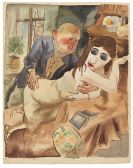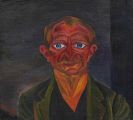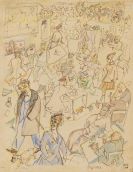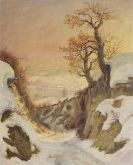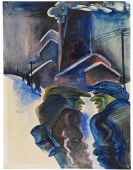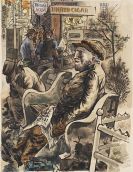
Rudolf Schlichter
Calw
1890 -
München
1955
Rudolf Schlichter was born in Calw on 6 December 1890. He began an apprenticeship as an enamel painter in Pforzheim in 1904 and then attended the Kunstgewerbeschule in Stuttgart from 1907 to 1910. He continued his studies at the Kunstakademie in Karlsruhe until 1916. He was drafted into the army, but released again after entering into a hunger strike and returned to Karlsruhe. Schlichter moved to Berlin in 1919 and joined the revolutionary "Novembergruppe". Then he associated himself with the Dadaists and later joined the Communist party. He left the "Novembergruppe" in 1920 and became the secretary of the Communist artist association "Rote Gruppe" in 1924.
Schlichter was soon considered one of the most important members of the "Neue Sachlichkeit"; Bert Brecht, Alfred Döblin, Oskar Maria Graf, Erich Kästner and Egon Erwin Kisch were among his friends. He made his living during this period with drawings and illustrations for various publishers. Schlichter abandoned the workers' movement at the end of the 1920s and associated with conservative intellectuals such as Ernst Jünger and re-joined the Catholic church.
At the end of his Dada-period Schlichter became a representative of the veristic wing of the "Neue Sachlichkeit". Art became his weapon in the political fight against the upper classes and militarism. His favoured sujets were depictions of the city, street scenes, the sub-culture of the intellectual bohème and the underworld, portraits and erotic scenes.
At the beginning of the 1930s Schlichter wrote his autobiography in two volumes: "Das widerspänstige Fleisch" and "Tönerne Flüsse".
A regime-critical drawing which Schlichter made for the Catholic youth magazine "Junge Front" led to his expulsion from the "Reichskammer der Bildenden Künste" in 1934, other works were confiscated and shown at the exhibition "Entartete Kunst".
In 1939 the artist moved to Munich contacted a circle of catholics around the magazine "Hochland" during the following years. This circle also included the publisher C. Muth, Theodor Hacker and Hans Scholl. In 1942 some of Schlichter's works burned in the destruction of his studio through bombs.
One year after the war in 1946, Schlichter participated in the "1. Deutsche Kunstausstellung" in Dresden, in which he came to the fore with his surrealistic late works. He explained his turn to Surrealism in his text "Das Abenteuer der Kunst", which was published by the Rowohlt Verlag in 1949.
After a short illness Rudolf Schlichter died in Munich on 3 May 1955.
Would you like to sell a work by Rudolf Schlichter?
Infos for seller

